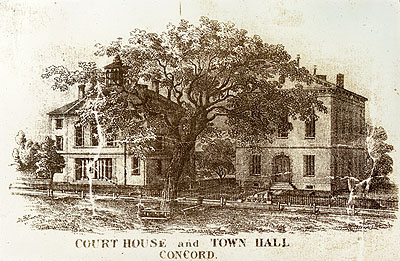The Italianate brick Town House at 22 Monument Square has been the hub of municipal activity in Concord since 1851. During much of the nineteenth century, it also served as a center of local social, cultural, and political life. For some time after it was constructed, the building was variously referred to as the Town House and the Town Hall, the latter name also used specifically for the large meeting and function room within the Town House.
In 1849, a fire destroyed the Middlesex County Courthouse on the lot just to the northwest of the present Town House site. Although the town had been granted the right to hold town meetings in the large county courtroom since 1721, that privilege was not renewed when the courthouse was rebuilt. As a result, Concord moved quickly to build its own town hall. Funds for it were authorized at town meeting in 1850. Later that year, the town paid John Shepard Keyes $1200 for the property on which his law office stood, and auctioned the superfluous building. In that auction, Keyes bought the building back. He subsequently moved it to Monument Street, where it now stands as no. 15.
Under a building committee headed by John M. Cheney, Boston architect Richard Bond was hired to design a new $30,000 town house. (Bond- whose work included Lewis Wharf in Boston - was the designer for at least one other Concord building project, the remodeling and enlargement of the First Parish in 1841.) The plans called for the town meeting hall to fill the second floor of the building, and for town offices, a safe for town records, a room for the Town Library (Concord's first public library), and two schoolrooms - for the high school and the intermediate school - to occupy the first floor. The library was so popular that in 1860 its space was expanded into part of the intermediate school room, and the high school room was divided for the use of both levels. After the high school moved to its own building in the early 1860s, the first floor was used for the armory and a dance hall that could be hired by private parties.
In 1879/80, an addition designed by George B. Thayer and built by the Maine firm of Foster & Dutton was added to the rear of the Town House. It provided rooms subsidiary to the large open hall on the second floor, including much-needed "water and other closets," and a dressing room for "females on social occasions" (urged as early as the 1871/72 Concord town report).
The building still served multiple purposes through most of the 1880s. Then, when the armory moved to its own building on Walden Street in 1888, the Town House was made over for more intensive municipal use, allowing the housing of the Police Department and the water, sewer, and electric light offices as well as those of the Town Clerk and Assessors in it. For many years, several other buildings were located on the rear part of the Town House lot. A small hose house for the Fire Department and two sheds, one originally built to house the cannon of the Concord Artillery, were located just north of the rear corner of the building until the early part of the twentieth century, when one of the sheds was removed, the other converted to a garage, and the hose house became the auto repair shop for town vehicles.
Concord proposed improvements to its Town House a number of times in the twentieth century - 1915/16, 1947, 1997. The "Report of the Special Town Plans Committee" in the 1947 printed town report offered the construction of a new town building on a different site and the conversion of the high school building on Stow Street to municipal purposes as alternatives to repeated renovation of the old building. Although the Special Town Plans Committee projected in 1947 that renovations "will prolong the usefulness of the present building for the 20 or more years which will probably elapse before new Town offices need be provided," Concord's municipal life today still revolves around the much-refurbished brick structure on Monument Square. This building - where Emerson once spoke, where Bronson Alcott presided over school exhibitions, where John Brown's death was solemnly observed, where Concord Lyceum programs were held - is widely regarded as a historic landmark in its own right.
The overview on this page was adapted from the Town House survey form in Survey of Historical and Architectural Resources of Concord, Massachusetts (Vol. 3, Form No. 302) [revised edition, 2002], by permission of the Concord Historical Commission ( http://www.concordma.gov/Pages/ConcordMA_HistComm/index )

